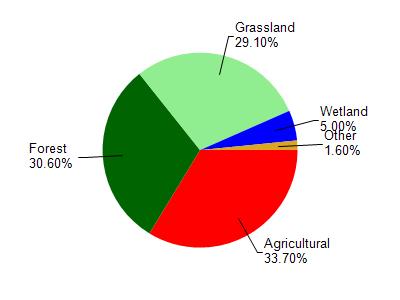Dunn, St. Croix
Yes
No
No
Fish and Aquatic Life
Overview
Sandy Creek is a 12-mile-long tributary to Tiffany Creek and is managed as a Class I trout fishery
in the upper 5.2 miles and as a Class I1 trout fishery in the lower 6.8 miles. Water resource
problems include bank erosion, especially in wooded areas, streambank pasturing, ditchtng and
sedimentation. The Class 11 section of this creek has the potential to improve to a Class I stream
with the control of nonpoint pollution sources (Schreiber).
Date 1996
Author Aquatic Biologist
Historical Description
Sandy Creek -T30N, R15W, Sec. 3 to T30N, R15W, Sec. 24, Surface Acres = 2.7, Miles = 5.5, Gradient = 19 feet per mile.
Flows southeast into Dunn County and the Hay River drainage system. This stream is managed for brook trout. A small spring feeder stream enters from Section 13, Township 30 North, Range 15 West. This feeder is considered to be a forage-minnow stream. It has no public frontage other than the access that may be had from the 5 road bridges.
From: Sather, LaVerne M. and Threinen, C.W., 1961. Lake and Stream Classification Project. Surface Water Resources of St. Croix County, Wisconsin Department of Natural Resources, Madison, WI.
Date 1961
Author Surface Water Inventory Of Wisconsin
General Condition
Sandy Creek (WBIC 2071800) from its mouth upstream to CTH X was assessed during the 2018 listing cycle; new biological (fish Index of Biotic Integrity (IBI) scores) sample data were clearly below the 2018 WisCALM listing thresholds for the Fish and Aquatic Life use. This water was meeting this designated use and was not considered impaired.
Date 2017
Author Ashley Beranek
Condition
Wisconsin has over 84,000 miles of streams, 15,000 lakes and milllions of acres of wetlands. Assessing the condition of this vast amount of water is challenging. The state's water monitoring program uses a media-based, cross-program approach to analyze water condition. An updated monitoring strategy (2015-2020) is now available. Compliance with Clean Water Act fishable, swimmable standards are located in the Executive Summary of Water Condition in 2018. See also the 'monitoring and projects' tab.
Reports
Management Goals
Wisconsin's Water Quality Standards provide qualitative and quantitative goals for waters that are protective of Fishable, Swimmable conditions [Learn more]. Waters that do not meet water quality standards are considered impaired and restoration actions are planned and carried out until the water is once again fishable and swimmable
Management goals can include creation or implementation of a Total Maximum Daily Load analysis, a Nine Key Element Plan, or other restoration work, education and outreach and more. If specific recommendations exist for this water, they will be displayed below online.
Monitoring
Monitoring the condition of a river, stream, or lake includes gathering physical, chemical, biological, and habitat data. Comprehensive studies often gather all these parameters in great detail, while lighter assessment events will involve sampling physical, chemical and biological data such as macroinvertebrates. Aquatic macroinvertebrates and fish communities integrate watershed or catchment condition, providing great insight into overall ecosystem health. Chemical and habitat parameters tell researchers more about human induced problems including contaminated runoff, point source dischargers, or habitat issues that foster or limit the potential of aquatic communities to thrive in a given area. Wisconsin's Water Monitoring Strategy was recenty updated.
Grants and Management Projects
| Project Name (Click for Details) | Year Started |
|---|
|
|
Monitoring Projects
| WBIC | Official Waterbody Name | Station ID | Station Name | Earliest Fieldwork Date | Latest Fieldwork Date | View Station | View Data |
|---|
| 2071800 | Sandy Creek | 10011822 | Sandy Creek - 3-Sandy Creek. 50' U.S. Of 50th St. | 1/1/2015 | 9/29/2015 | Map | Data |
| 2071800 | Sandy Creek | 10037537 | Sand Creek DS of 150th Ave | 6/25/2012 | 1/1/2015 | Map | Data |
| 2071800 | Sandy Creek | 10011825 | Sandy Creek - 5-Sandy Creek. 50' U.S. Of Sandy Creek Rd. | 1/1/2015 | 1/1/2015 | Map | Data |
| 2071800 | Sandy Creek | 10011824 | Sandy Creek - 4-Sandy Creek. 50' U.S. Of Sandy Creek Rd. | | | Map | Data |
| 2071800 | Sandy Creek | 10011818 | Sandy Creek - 1-Sandy Creek. 50' U.S. Of Cth Q | 1/1/2015 | 1/1/2015 | Map | Data |
| 2071800 | Sandy Creek | 10011819 | Sandy Creek - 2-Sandy Creek. 50' U.S. Of 50th St. | 4/22/1994 | 4/22/1994 | Map | Data |
| 2071800 | Sandy Creek | 10010803 | Sandy Creek - Sandy Creek 6 Cth X | 10/6/1998 | 1/1/2015 | Map | Data |
|

Watershed Characteristics
Sandy Creek is located in the South Fork Hay River watershed which is 181.99 mi². Land use in the watershed is primarily agricultural (33.70%), forest (30.60%) and a mix of grassland (29.10%) and other uses (6.60%). This watershed has 399.14 stream miles, 412.20 lake acres and 6,405.93 wetland acres.
Nonpoint Source Characteristics
This watershed is ranked Not Available for runoff impacts on streams, Not Available for runoff impacts on lakes and High for runoff impacts on groundwater and therefore has an overall rank of High. This value can be used in ranking the watershed or individual waterbodies for grant funding under state and county programs.However, all waters are affected by diffuse pollutant sources regardless of initial water quality. Applications for specific runoff projects under state or county grant programs may be pursued. For more information, go to surface water program grants.